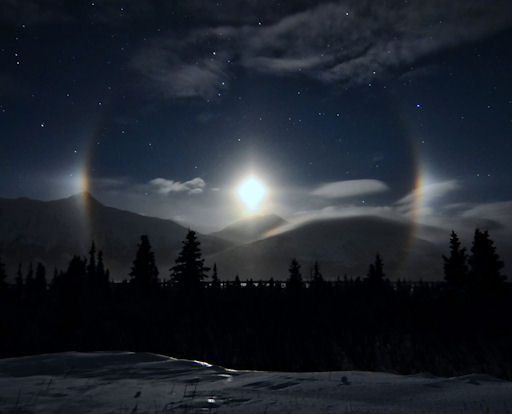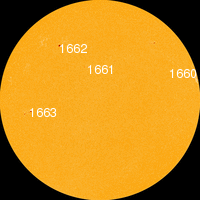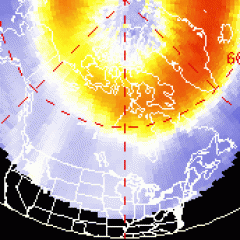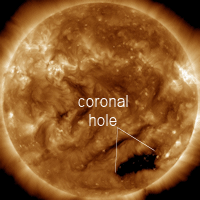THE QUIET CONTINUES: For the 7th day in a row, solar activity is very low. None of the sunspots on the Earthside of the sun is actively flaring. NOAA forecasters put the odds of an M-class solar flare today at no more than 5%. Solar flare alerts: text, voice.
NORTHERN LIGHTS: A solar wind stream hit Earth's magnetic field on Jan. 26th, sparking auroras around the Arctic Circle. The moon was full at the same time, shining like a floodlight, but the auroras were bright enough to be seen anyway:
Matt Melnyk took the picture from a spot just outside Edmonton, Alberta. "The Moon was bright but it did not stop the aurora from showing!" he says. "The display started off dim then exploded into a vast array of green and purple."
NOAA forecasters estimate a 40% chance of polar geomagnetic storms on Jan. 27th. However, Earth is exiting the solar wind stream, and this will reduce the chances of more bright Northern Lights tonight. Aurora alerts: text, voice.
FULL MOONDOGS: It's winter, the air is filled with ice, and the Moon is waxing full--perfect conditions for a moondog. Sebastian Saarloos photographed a pair of them flanking the Moon over Lower Miller Creek, Alaska:
"Paraselene is the scientific name for a moondog," says Saarloos. "The phenomenon is caused by moonlight shining through ice crystals in the air." Hexagonal plate-shaped crystals, fluttering down from the clouds like leaves from trees, refract moonbeams into rainbow-colored splashes of light 22o to the right and left of the Moon, as shown above.
Moondogs are most often seen on the nights around a full Moon. That means now is the time to look. The Moon is 100% illuminated on the night of Jan. 26-27, so be alert for moondogs!

![]()
Solar wind
speed: 432.8 km/sec
density: 1.7 protons/cm3
explanation | more data
Updated: Today at 1826 UT
![]()
X-ray Solar Flares
6-hr max: B2 1557 UT Jan27
24-hr: B2 1557 UT Jan27
explanation | more data
Updated: Today at: 1800 UT
![]()
![]()
![]()
Daily Sun: 27 Jan 13
![]()
![]()
None of these sunspots is actively flaring. Credit: SDO/HMI
![]()
![]()
![]()
Sunspot number: 55
What is the sunspot number?
Updated 27 Jan 2013
Spotless Days
Current Stretch: 0 days
2013 total: 0 days (0%)
2012 total: 0 days (0%)
2011 total: 2 days (<1%)
2010 total: 51 days (14%)
2009 total: 260 days (71%)
Since 2004: 821 days
Typical Solar Min: 486 days
Update 27 Jan 2013
The Radio Sun
10.7 cm flux: 99 sfu
explanation | more data
Updated 27 Jan 2013
![]()
![]()
![]()
Current Auroral Oval:
![]()
Switch to: Europe, USA, New Zealand, Antarctica
Credit: NOAA/POES
![]()
![]()
![]()
Planetary K-index
Now: Kp= 1 quiet
24-hr max: Kp= 4 unsettled
explanation | more data
![]()
Interplanetary Mag. Field
Btotal: 3.2 nT
Bz: 0.9 nT south
explanation | more data
Updated: Today at 1827 UT
![]()
![]()
![]()
Coronal Holes: 26 Jan 13
![]()
![]()
Solar wind flowing from this southern coronal hole should reach Earth on Jan. 26-27. Credit: SDO/AIA.






